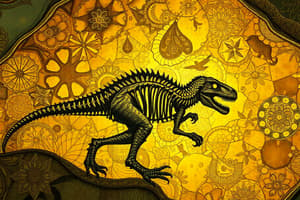Podcast
Questions and Answers
What is the maximum age that carbon dating can effectively measure?
What is the maximum age that carbon dating can effectively measure?
- 100,000 years
- 50,000 years (correct)
- 25,000 years
- 5,000 years
What type of bond forms when electrons are shared equally between two atoms?
What type of bond forms when electrons are shared equally between two atoms?
- Non-polar covalent bond (correct)
- Metallic bond
- Polar covalent bond
- Ionic bond
Which of the following describes an anion?
Which of the following describes an anion?
- A neutral atom
- An ion formed by gaining electrons (correct)
- An ion formed by losing electrons
- An ion that has equal protons and electrons
What characterizes ionic bonds?
What characterizes ionic bonds?
How can the concentration of 14C in a fossil help determine its age?
How can the concentration of 14C in a fossil help determine its age?
What happens to sodium when it loses an electron?
What happens to sodium when it loses an electron?
Which element is referred to as 'chloride' in its ionic form?
Which element is referred to as 'chloride' in its ionic form?
What type of bond is generally the strongest and most common in organisms?
What type of bond is generally the strongest and most common in organisms?
What distinguishes isotopes of the same element?
What distinguishes isotopes of the same element?
What is the mass number of an element determined by?
What is the mass number of an element determined by?
Which statement regarding carbon-14 is true?
Which statement regarding carbon-14 is true?
After how many years will the concentration of Carbon-14 be reduced to half its initial level?
After how many years will the concentration of Carbon-14 be reduced to half its initial level?
What role do neutrons play in the nucleus of an atom?
What role do neutrons play in the nucleus of an atom?
Which of the following is NOT a characteristic of neutral atoms?
Which of the following is NOT a characteristic of neutral atoms?
What happens to carbon-14 after an organism dies?
What happens to carbon-14 after an organism dies?
How can the number of neutrons in an element be determined?
How can the number of neutrons in an element be determined?
What causes polar covalent bonds to form between atoms?
What causes polar covalent bonds to form between atoms?
What happens to the charge of hydrogen in a water molecule due to its bonding with oxygen?
What happens to the charge of hydrogen in a water molecule due to its bonding with oxygen?
What type of interaction occurs between two polar molecules?
What type of interaction occurs between two polar molecules?
How do hydrogen bonds affect the physical properties of water?
How do hydrogen bonds affect the physical properties of water?
Why are hydrogen bonds crucial for life as we know it?
Why are hydrogen bonds crucial for life as we know it?
What percentage of the human body is composed of water?
What percentage of the human body is composed of water?
What is the effect of water's polarity on its interactions with other molecules?
What is the effect of water's polarity on its interactions with other molecules?
What primarily accounts for oxygen's high electronegativity?
What primarily accounts for oxygen's high electronegativity?
What are the three components that make up a nucleotide?
What are the three components that make up a nucleotide?
Which statement about DNA's structure is accurate?
Which statement about DNA's structure is accurate?
How do nucleotides combine to form DNA or RNA?
How do nucleotides combine to form DNA or RNA?
Which type of sugar is found in DNA nucleotides?
Which type of sugar is found in DNA nucleotides?
In addition to DNA, what role do other types of RNA play?
In addition to DNA, what role do other types of RNA play?
What causes a steel needle to float on the surface of water?
What causes a steel needle to float on the surface of water?
What property allows water to travel up a straw?
What property allows water to travel up a straw?
Which of the following pH values represents a highly acidic solution?
Which of the following pH values represents a highly acidic solution?
How much does the concentration of hydrogen ions change when the pH changes from 5 to 3?
How much does the concentration of hydrogen ions change when the pH changes from 5 to 3?
What is the pH of pure water?
What is the pH of pure water?
Which of the following is a characteristic of bases?
Which of the following is a characteristic of bases?
What is the pH of orange juice approximately?
What is the pH of orange juice approximately?
Which statement about pH is true?
Which statement about pH is true?
Flashcards are hidden until you start studying
Study Notes
Carbon Dating
- Half-life is the time it takes for half of the original concentration of an isotope to decay.
- Carbon-14 (14C) has a long half-life and is used to date formerly living objects.
- By comparing the 14C concentration in an object to atmospheric levels, scientists can determine the age of fossils up to 50,000 years old.
- Isotopes with longer half-lives, like potassium-40, are used to date older fossils.
Chemical Bonds
- Elements interact based on the number and arrangement of their electrons.
- Ions are formed when an atom has an unequal number of protons and electrons.
- Cations are positively charged ions formed by losing electrons.
- Anions are negatively charged ions formed by gaining electrons.
- Ionic bonds form between oppositely charged ions.
- Covalent bonds form when electrons are shared between two atoms.
- Covalent bonds are the strongest and most common type in organisms.
- Non-polar covalent bonds occur when electrons are shared equally.
- Polar covalent bonds occur when electrons are shared unequally due to differences in electronegativity.
- Hydrogen bonds form between polar molecules due to the attraction of opposite charges.
Water
- Water is essential for life.
- Water is polar due to the uneven sharing of electrons in its covalent bonds.
- Cohesion and surface tension are properties of water due to hydrogen bonding.
- Adhesion is the attraction between water molecules and other molecules.
pH, Acids, and Bases
- The pH scale measures the acidity or alkalinity of a solution.
- A change of one pH unit represents a tenfold change in hydrogen ion concentration.
- Pure water is neutral with a pH of 7.
- Acids donate hydrogen ions (H+), lowering pH.
- Bases donate hydroxide ions (OH-), raising pH.
DNA & RNA
- DNA and RNA are made up of nucleotides.
- Each nucleotide consists of a nitrogenous base, a pentose sugar, and a phosphate group.
- DNA has a double-helix structure.
Studying That Suits You
Use AI to generate personalized quizzes and flashcards to suit your learning preferences.



